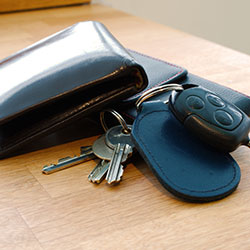
What's your auto insurance deductible? Typically, drivers have a car insurance deductible that's about $500. But, some drivers have a deductible that's $1,000. If you hear about a driver with a deductible that's $1,000, chances are they raised their deductible. A person can raise their deductible if they want to pay lower premiums each month or annually. Is this a good decision for you if you want a lower monthly payment? Let's take a look at the pros and cons of having a higher deductible.
What is an Auto Insurance Deductible?
An auto insurance deductible is the amount that you would pay out-of-pocket toward a claim. You might file a claim with your auto insurer if there's damage to your vehicle from fire, water damage or theft. Another occasion when you might consider filing a claim is if you were involved in an accident.
When you set up your policy, you establish the deductible amount with your insurance professional in your initial call or online insurance quote. Your deductible is the share of risk that you pay to be insured. It's applied to your comprehensive and collision coverage. If you had liability coverage only, you may not have a deductible. Liability coverage helps if you hit another vehicle and it pays for damage to the other vehicle while comprehensive and collision cover damage to your vehicle.
When setting up insurance quotes, some drivers accept the terms which might include a $500 deductible amount. While others change the deductible or the terms if they want to make other payment arrangements. They might want to pay annual payments or a lump sum payment each year. This can help them avoid service fees on their insurance premium. Another way that they can benefit from an insurance discount is if they raise their deductible amount.
Why Raise Your Deductible?
Raising your deductible is a decision that you should think through carefully. When a person raises their deductible, they might do so to lower their payments without realizing they'll pay more out-of-pocket later. Or, they're strategically raising their deductible because they know they have the extra money in savings if they need to file a claim. If you change your deductible from $500 and make it $1000 you might save 5 to 10 percent on payments.
There are a few pros and cons associated with having a higher deductible:
Pros of Raising Your Deductible
- You'll have lower monthly premiums or a lower annual payment
Cons of Raising Your Deductible
- You'll have a larger amount to pay out-of-pocket if you file a claim
- If you file a claim and don't have the money to cover repairs you can't fix your vehicle
How to Increase or Lower Your Deductible
If you decide that you want to change your deductible, contact your insurance carrier. You can call and ask to make changes to your deductible. If you want to raise it, confirm that that your premium will change. If you're only raising your deductible as a way to increase your savings, there are insurance discounts to consider too.
Ways to Get Insurance Discounts
If you're interested in an insurance discount, here are a few ways to save on auto insurance:
- Set up a multi-vehicle policy
- Bundle your home and auto insurance
- Drive less frequently and commute or carpool to work
- Sign up for telematics to track your driving
- Take a driver's education course
- If you're a student, have good grades
- If you're a younger driver, turn 25 for a lower insurance rate
- Maintain a clean driving record
- Comparison shop for cheaper car insurance rates online
Ready to Find the Best Insurance Rates?
You can raise your insurance deductible if you want to have lower monthly or annual payments. Contact your insurer to make the change and only do so if you have enough money in savings to cover your deductible amount out-of-pocket. With other ways to lower your premiums, you might be able to find more savings.
With Kanetix.ca, you can compare insurance quotes from the leading insurers in Canada (and save a few hundred dollars!).




